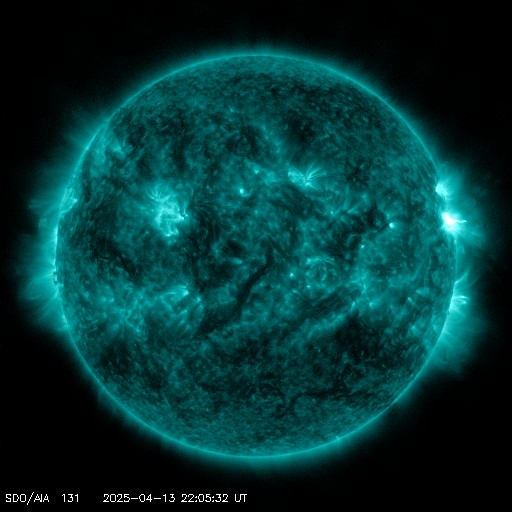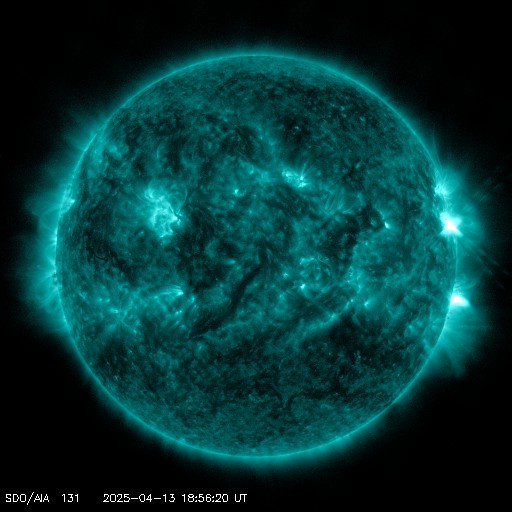Viewing archive of Friday, 6 December 2013
Daily bulletin on solar and geomagnetic activity from the SIDC
Issued: 2013 Dec 06 1253 UTC
SIDC Forecast
Solar flares
Eruptive (C-class flares expected, probability >=50%)
Geomagnetism
Active conditions expected (A>=20 or K=4)
Solar protons
Quiet
| 10cm flux | Ap | |
|---|---|---|
| 06 Dec 2013 | 150 | 007 |
| 07 Dec 2013 | 152 | 018 |
| 08 Dec 2013 | 153 | 011 |
Bulletin
The GOES X-ray background radiation is at the C-level. Several C-class flares were observed during the past 24h, mainly in NOAA AR 1909 and in the returning regions on the east limb. We expect more C-flares, especially from these east limb regions, with a small chance for an M-class flare. A large scale filament eruption was observed on December 04, starting from 11:00 UT. This resulted in a slow CME, mainly oriented towards the north. Another filament erupted in AR 1909 around 21 UT on December 5th. While there is a gap in LASCO data, COR2-A images clearly show the associated slow CME. The activity on the east limb also resulted in several CMEs towards the SE (as seen from LASCO). We expect unsettled to active conditions (up to K=4) on December 7 due to the arrival of a coronal hole high speed wind stream. This coronal hole, which seems to have increased in size in the last 24h, passed the central meridian on December 4. Afterwards, geomagnetic conditions should return to quiet conditions until December 9th when Earth may feel the influence from the ICME associated with the filament eruption in AR 1909. A glancing blow from the east limb CMEs is also possible.
Today's estimated international sunspot number (ISN): 065, based on 14 stations.Solar indices for 05 Dec 2013
| Wolf number Catania | 148 |
| 10cm solar flux | 150 |
| AK Chambon La Forêt | 008 |
| AK Wingst | 004 |
| Estimated Ap | 003 |
| Estimated international sunspot number | 078 - Based on 12 stations |
Noticeable events summary
| Day | Begin | Max | End | Loc | Strength | OP | 10cm | Catania/NOAA | Radio burst types | |
|---|---|---|---|---|---|---|---|---|---|---|
| None | ||||||||||
Provided by the Solar Influences Data analysis Center© - SIDC - Processed by SpaceWeatherLive
All times in UTC
Current data suggests there is a slight possibility for aurora to appear at the following high latitude regions in the near future
Gillam, MB, Iqaluit, NUNuuk
Reykjavik
Latest news
Latest forum messages
Support SpaceWeatherLive.com!
A lot of people come to SpaceWeatherLive to follow the Sun's activity or if there is aurora to be seen, but with more traffic comes higher server costs. Consider a donation if you enjoy SpaceWeatherLive so we can keep the website online!

Latest alerts
Sunday, 13 April 2025
22:21 UTC - Solar flare
Moderate M1.66 flare from sunspot region 4055
22:03 UTC - Radio Blackout
Minor R1 radio blackout in progress (≥M1 - current: M1.01)
20:48 UTC - Hemispheric Power Index
The OVATION model predicts the Hemispheric Power Index to reach 50GW at 21:39 UTC
19:09 UTC - Solar flare
Moderate M3.24 flare from sunspot region 4055
18:51 UTC - Radio Blackout
Minor R1 radio blackout in progress (≥M1 - current: M1.07)
Space weather facts
| Last X-flare | 2025/03/28 | X1.1 |
| Last M-flare | 2025/04/13 | M1.6 |
| Last geomagnetic storm | 2025/04/06 | Kp5 (G1) |
| Spotless days | |
|---|---|
| Last spotless day | 2022/06/08 |
| Monthly mean Sunspot Number | |
|---|---|
| March 2025 | 134.2 -20.4 |
| April 2025 | 136.4 +2.2 |
| Last 30 days | 134.2 -8.9 |




